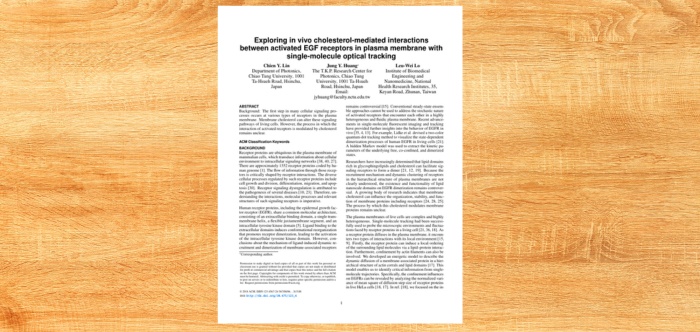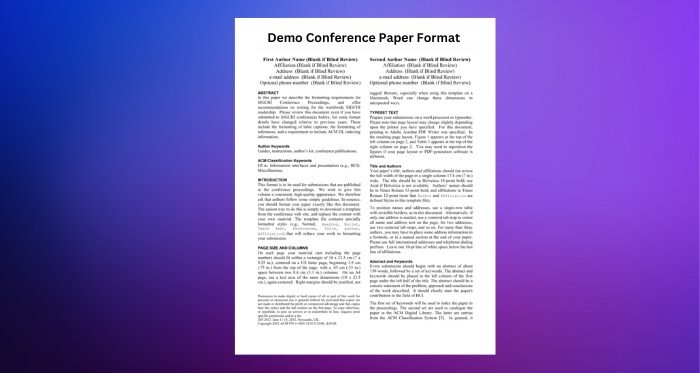Imagine a magical world where your research and ideas could reach an eager audience of fellow academics and experts. Well, that world exists in the form of academic conferences. They’re like big idea-sharing parties! But wait, there’s a catch, you need to present your research in a specific way, and that’s where the conference paper format comes into play.
Conference papers typically include an abstract, title, introduction, objectives, methods, results, discussion, conclusion, acknowledgments, and references. Some may also feature a problem statement, literature review, or funding note.
In this blog, we’ll unlock the secrets of conference paper formatting, helping your research shine, captivate your peers, and make a lasting impact. Join us in exploring this world and making your work sparkle!
What Does the Conference Paper Entail?
Conference papers are short documents for sharing research. They follow a specific structure with parts like the abstract, title, introduction, methods, results, discussion, conclusion, and references. Some papers also include sections like a problem statement or literature review.
The abstract is a quick summary, and the title should be short and catchy. The introduction sets the scene, the methods explain how the study was done, the results show what was found, and the discussion explains the findings. The conclusion summarizes everything. Acknowledgments thank those who helped, and references cite other research.
To make a good conference paper, keep formatting consistent, cite sources properly, and use visuals wisely. Follow conference rules, and check for mistakes in writing. Avoid confusing jargon, messy organization, and citation errors. By understanding these basics, researchers can write papers that shine and contribute to their fields. These conference papers are submitted/published at different conferences, for instance, the International Arts, Education, and Humanities Conference.
Conference Paper Format
Creating a conference paper is a vital task for researchers to share their discoveries effectively with peers. The conference paper format is key to how your research is received. This guide will help you navigate the essential elements and best practices to make your conference paper stand out.
Abstract: Summarizing Your Work
Your paper’s abstract serves as a concise summary, offering a snapshot of your research’s purpose, methodology, and key findings. It’s your opportunity to entice readers and convince them to delve deeper into your work.
Title: Craft a Compelling Headline
A well-crafted title is your paper’s first impression. It should be concise, engaging, and reflective of the paper’s central theme. A compelling title piques curiosity and encourages readers to explore further.
Introduction: Set the Stage
The introduction sets the context for your research, providing background information, explaining the problem or questions your study addresses, and outlining your objectives. A clear and compelling introduction guides readers into the heart of your research.
Methodology: The Roadmap of Your Study
In this section, you detail the methods and techniques used in your research. Describe your approach transparently so that others can replicate your work if needed. Clarity and precision are key here.
Results and Findings: Presenting Your Discoveries
Present your research outcomes with clarity. Use figures and tables judiciously to convey complex information effectively. Ensure your findings directly relate to your research objectives. Discuss any unexpected findings and their potential implications.
Discussion: Interpretation and Implications
Engage your readers by interpreting your findings and discussing their implications. Address how your research contributes to the broader field and any limitations encountered during the study.
Conclusion: Summarize Key Takeaways
In your conclusion, reiterate the main findings and their significance. Provide a concise summary of the paper’s contributions and potential avenues for future research. Leave the reader with a clear understanding of the value your research brings to the field.
Acknowledgments: Recognize Contributions
Acknowledge individuals or organizations that supported your research. Gratitude goes a long way in fostering collaborative relationships within the academic community. Mention any grants or funding sources that facilitated your work.
References: Cite Sources Properly
Ensure your paper’s credibility by citing all relevant sources correctly. Follow a consistent citation style as per the conference’s guidelines. Maintain a comprehensive and well-organized reference list to facilitate further exploration of your topic.
Exploring the Future Trends in Conference Paper Formats
The world of conference paper formats is evolving rapidly, adapting to the changing needs of researchers and the advancements in technology. In this section, we’ll take a glimpse into the emerging trends that are reshaping the way we share and consume research.
Digital and Interactive Presentations
The future holds a shift towards digital and interactive conference presentations. Researchers are increasingly using multimedia elements, such as videos, animations, and interactive graphics, to convey their findings more dynamically.
Open Access and Online Conferences
Online conferences and open-access platforms are becoming more prevalent. This trend offers wider accessibility to research, breaking down geographical barriers and fostering global collaboration.
Integration of Artificial Intelligence
Artificial intelligence (AI) is playing a more prominent role in the research process. AI algorithms are assisting researchers in data analysis, enhancing the quality of findings, and automating certain aspects of paper preparation.
Enhanced Data Visualization
Data visualization techniques are evolving to make complex research data more understandable. Augmented reality and 3D visualization tools are being explored to offer a richer understanding of research outcomes.
Cross-disciplinary Collaboration
Future conferences are likely to encourage cross-disciplinary collaboration. Researchers from diverse fields will converge to address complex global challenges, resulting in innovative and holistic solutions.
Technological Advancements in Presentation Tools
As technology progresses, conference presentation tools are becoming more sophisticated. Augmented reality (AR), virtual reality (VR), and AI-driven presentation assistance tools will revolutionize how researchers communicate their work.
Common Pitfalls in Conference Paper Preparation
While crafting your conference paper is crucial, steering clear of common pitfalls is equally vital. These missteps can hinder your paper’s effectiveness in conveying your research. Let’s explore these pitfalls and learn how to avoid them to ensure your research shines at conferences.
- Excessive Jargon: Using too much technical language can alienate readers. Aim for clarity to engage a broader audience.
- Disorganized Content: Poorly structured papers confuse readers. Maintain a logical flow to guide them through your research seamlessly.
- Lack of Clarity: Unclear writing makes it challenging for readers to grasp your research. Proofread for clarity and concise expression.
- Ignoring Conference Guidelines: Each conference may have specific formatting and submission rules. Failure to follow them can result in rejection.
- Neglecting Revisions: Submitting without peer review and revisions can lead to overlooked errors and missed opportunities for improvement.
- Misusing Visuals: Poorly chosen or excessive visuals can clutter your paper. Use them judiciously to enhance, not overwhelm, your message.
- Ignoring Peer Feedback: Neglecting feedback from peers or reviewers can hinder paper quality and overlook valuable insights.
- Inadequate Proofreading: Grammatical and typographical errors reflect negatively on your paper’s professionalism. Thoroughly proofread before submission.
By avoiding these pitfalls and paying attention to detail, you can enhance the quality and impact of your conference paper, ensuring it resonates with your peers and readers.
Tips for Effective Conference Paper Formatting
Conference paper formatting is more than just looks; it’s about clear communication and credibility. In this guide, we’ll explore essential tips for your paper to shine and make a lasting impact in the academic world.
Maintain Consistency in Style and Formatting:
Consistency in headings, fonts, and citation styles creates a polished and professional appearance throughout your paper, aiding reader comprehension. Make sure section headings are distinct and the hierarchy is clear.
Properly Cite Your Sources:
Accurately follow the citation style recommended by the conference guidelines. Proper citations enhance your paper’s credibility and legitimacy. Include a comprehensive list of references at the end of your paper.
Utilize Visual Aids Purposefully:
Incorporate figures and tables strategically to illustrate key points and enhance reader understanding. Ensure that visuals are clear, relevant, and well-labeled. Provide succinct captions to guide readers.
Adhere to Length and Style Guidelines:
Respect the specified paper length and adhere to the prescribed style requirements provided by the conference organizers. Deviating from these guidelines can lead to rejection. Additionally, maintain a consistent tone and writing style.
Thoroughly Proofread and Edit:
Review your paper meticulously for grammar, punctuation, and spelling errors. Effective editing ensures clarity and maintains professionalism. Consider seeking peer or professional editing assistance for a fresh perspective.
Follow Conference-Specific Requirements:
Pay careful attention to any unique guidelines outlined by the conference organizers. This may include specific formatting instructions, file formats for submission, or word count limitations. Failure to adhere to these specific requirements can result in rejection.
By following these comprehensive tips, you can present your research effectively, increase your paper’s impact, and successfully engage your academic audience.
Conclusion
Understanding the conference paper format is crucial for researchers. These papers are about clarity and credibility. As you craft each section, from the abstract to the discussion, remember that simplicity enhances your paper’s impact at conferences.
Looking ahead, exciting trends like digital presentations and AI integration are shaping the future of conference papers. Avoid common pitfalls, maintain consistency, and use visuals wisely. By following these practices, your research will shine.
Embrace the power of effective conference paper formatting to engage your audience, leave a significant mark, and enrich your field. Armed with these insights, you’re well-prepared to excel in the realm of academic presentations and research sharing.








